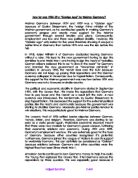Account for the political stability of the Weimar between 1924-29
In answering this question I propose to examine the key areas of leadership, the economy, then see how this affected politics and follow this up by looking at foreign relations.
1924 saw the emergence of two figures in key posts that were to contribute to Weimar stability between these years: Stresemann and Hindenburg. Both had militarist and nationalist backgrounds but similarly both were intelligent enough to realise that co-operation and discourse were preferable to civil war and economic suffering. Stresemann masterminded Germany’s period of diplomatic tension and isolation whilst Hindenburg offered a presidency that was balanced and tactfully administered. Both men were acceptable as leaders to the majority of German people for the time being. These men seemed acceptable to the allies whose goodwill was of paramount importance for German to recover between 24-29.







